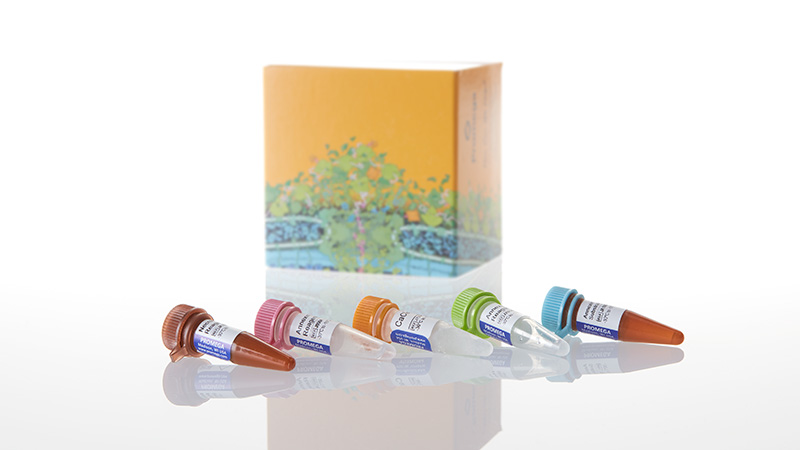인류의 건강과 생명공학 발전을 위해 봉사하는 기업 드림셀
We Serving the Health and Biotechnology of Humanity
We Serving the Health and Biotechnology of Humanity

제품코드 : JA1011
제품정보 : Apoptosis Assay
The RealTime-Glo™ Annexin V Apoptosis and Necrosis Assay measures the real-time exposure of phosphatidylserine (PS) on the outer leaflet of cell membranes during the apoptotic process. Annexin V luciferase fusion proteins supplied in the assay reagent bind to PS during early apoptosis and are detected with a simple luminescence signal. The assay reagent also includes a DNA-binding dye, which enters the cell and generates a fluorescent signal upon loss of membrane integrity.
The combination and timing of luminescent (annexin V binding) and fluorescent (DNA release) signals is used to differentiate secondary necrosis occurring during late apoptosis from necrosis caused by other cytotoxic events.
The RealTime-Glo™ Annexin V Apoptosis and Necrosis assay is non-lytic and the simple “add-and-read” method allows multiple readings from a single assay well. Apoptosis can be monitored in real time, without the need for multiple plates, complicated processing, or specialized detection equipment. A multimode reader capable of detecting luminescence and fluorescence is the only instrument required.
Based on NanoLuc® Binary Technology (NanoBiT), the RealTime-Glo™ Annexin V Apoptosis Assay uses Annexin V fusion proteins containing complementary subunits of NanoBiT® luciferase (Annexin V-LgBiT and Annexin V-SmBiT). When in close proximity, the LgBiT and SmBiT subunits come together to form a functional luciferase.
The Detection Reagent contains Annexin V-LgBiT and Annexin V-SmBiT (NanoBiT) fusion proteins and a profluorescent DNA dye.
Luminescence remains low until PS exposure brings the Annexin V fusion proteins close together, forming a functional luciferase.
A fluorescent signal is generated upon loss of membrane integrity during late stage apoptosis, when the DNA dye can enter the cell.
Measurement of Annexin V binding (luminescence) and loss of membrane integrity (fluorescence) repeatedly from the same sample well after exposure to a test compound allows resolution of the effects of cytotoxic stimuli and determination of mechanism of action. Here, the time delay between the emergence of phosphatidylserine : Annexin V binding and the loss of membrane integrity indicates an apoptotic phenotype that leads to secondary necrosis.

Different Doses, Multiple Time Points, One Assay Plate
With this real-time Annexin V assay, repeated measures of luminescence and fluorescence from the same well during compound exposure allow determination of compound potency using far fewer plates and less reagents than endpoint assays.
The reagent is well tolerated by a variety of cultured cell types and can be applied prior to treatment or at dosing for real-time measurement of the dose and time-dependent magnitude of apoptotic progression.
Multiple data points. One reagent addition. One assay plate.

Data for each dose was obtained at multiple time points using a single assay plate with one reagent addition.
Multiple data points. Multiple assay plates.

Here, 7 plates were needed to obtain the data that could be achieved using a single plate with the real-time assay.
See More Data: Learn more about this data and see how the RealTime-Glo™ Annexin V Apoptosis Assay can be used with various cell models exploring safety and exposure in the poster A Real-Time, Bioluminescent Annexin V Assay for the Assessment of Apoptosis, presented at SOT 2017.

In this experiment, K562 cells were exposed to various doses of bortezomib for 16 hours.
Top Panel: Cells were harvested, washed and labeled with Alexa Fluor® 488 (green fluorescence, phosphatidylserine:Annexin V binding) and 7-AAD (red fluorescence, membrane integrity) and analyzed by flow cytometry (10,000 events).
Bottom Panel: K562 cells (10,000/well) were exposed to serial dilutions of bortezomib in the presence of the RealTime-Glo™ Annexin V Apoptosis Assay reagent. Luminescence (phosphatidylserine:Annexin V binding) and fluorescence (membrane integrity) were recorded kinetically. The 16-hour incubation with bortezomib is shown.
See More Data: Additional data illustrating how the real time method can be used to differentiate modes of cell death is available in the Poster A Real-Time, Plate -based Annexin V Method for Monitoring Programmed Cell Death, presented at AACR 2017.
RealTime-Glo™ Annexin V Apoptosis and Necrosis Assay
(Cat.# JA1011 and JA1012)
Includes Necrosis Detection Reagent, a cell-impermeant profluorescent DNA dye. Upon loss of membrane integrity, the dye enters the cell and binds to DNA, generating a fluorescent signal.
RealTime-Glo™ Annexin V Apoptosis Assay
(Cat.# JA1000 and JA1001)
Does not include Necrosis Detection Reagent. Although the assay can be conducted without a necrosis detection probe, the mechanism of action of PS exposure will not be revealed. Therefore, when using Cat.# JA1000 or JA1001, we recommend incorporating an asymmetric cyanine dye such as CellTox™ Green (Cat.# G8742) or structurally related molecules, for full assay functionality and data clarity.